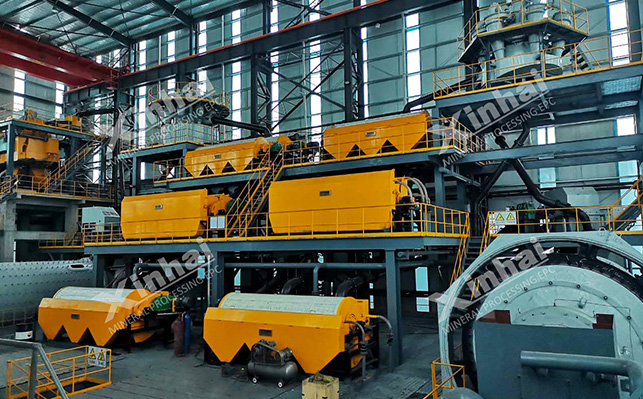Kaolin is one of the important inorganic fillers and can be used in ceramics, papermaking, coatings, rubber, chemicals and other fields. High-quality kaolin has high standards for purity and whiteness. In order to meet this standard, it is usually necessary to purify the kaolin ore, that is, to remove impurities such as iron, quartz, and mica to improve the purity of kaolin. Common purification methods include gravity separation, magnetic separation, flotation, chemical leaching, roasting and other methods are more commonly used. However, it is difficult to remove multiple impurities with only a single purification process, so a combined purification process is often used in actual production. This article introduces four commonly used kaolin combined purification processes.
The main function of the gravity separation purification process is to remove organic matter, manganese, iron, titanium and other elemental impurities, reduce the negative impact of impurities on whiteness, and achieve the purpose of purifying kaolin. The centrifugal process can be used to remove gangue particles, and the ultimate goal can be achieved based on the density difference of gangue particles. The proposed method of gravity separation of kaolin is effective. Using a centrifuge for washing and screening can achieve the purpose of washing and grading to remove impurities, and has very good application value. However, it is difficult to obtain kaolin products that meet the requirements by gravity separation alone. Usually, it is also necessary to combine with leaching, calcination and other processes.
For example, after gravity separation to remove some impurities, the leaching process can be carried out, and some impurities in kaolin can be selectively dissolved by leaching agents such as sulfuric acid and hydrochloric acid to further improve the purity of the product. Or a calcination process can be carried out to change the physical and chemical properties of kaolin by high temperature, and some impurities that are difficult to remove by other methods can be removed, so as to obtain kaolin products that meet the requirements.

Magnetic separation and purification are mostly used to remove weak magnetic impurities such as pyrite and hematite. Magnetic separation is very environmentally friendly, has no environmental pollution, and does not require the use of chemical agents, so it is widely used in many fields. Because magnetic separation technology can effectively remove weak magnetic impurity particles in kaolin, it effectively realizes the magnetic separation and purification of non-metallic minerals. Many companies use SLon vertical ring high gradient magnetic separator for purification and screening. Magnetic separators have also been improved with the advancement of science and technology. Reasonable control of the rotation speed has prevented some parts from secondary pollution. In addition, superconducting magnetic separators have also been used for magnetic separation and iron removal of kaolin. Not only is the magnetic field strength further improved, and higher quality kaolin can be obtained, but also energy consumption is reduced and the footprint is small.
However, it is difficult to obtain high-grade kaolin products with a single magnetic separation process, and it needs to be combined with other processes. For example, in combination with the chemical bleaching process, the Fe₂O₃ content of the original ore is 1.4-4%. After magnetic separation, chemical bleaching can further reduce the iron content and improve the whiteness of the product.
Flotation processes are widely used in kaolin purification, mainly including selective flocculation, carrier flotation, double liquid layer flotation, etc. Selective flocculation is to use the differences in the physical and chemical properties of the surfaces of different mineral components to flocculate the target mineral particles into agglomerates and separate them from suspended particles. Carrier flotation uses the mineral particles of general flotation particles as carriers to cover the fine particles of the target minerals on the carriers for flotation. Double-liquid layer flotation uses the difference in interfacial tension between solid, liquid and oil phases to enrich fine minerals at the oil-water interface or extract mineral particles into the organic phase. Flotation technology is often used in combination with magnetic separation, chemical bleaching and other methods.
For example, flotation is first performed to remove some impurities, then magnetic separation is performed to remove weak magnetic impurities, and finally chemical bleaching is used to further improve the whiteness of the product, thereby realizing the comprehensive utilization of low-grade kaolin resources.
Chemical purification uses the characteristics of acid solubility or alkali solubility of certain associated impurities in minerals, and uses acid or alkali to dissolve and remove them. For high-iron and high-titanium kaolin, the reduction method, oxidation-reduction method, acid leaching, reduction-complexation method and other methods can be used for mineral processing, purification and whitening. Among them, the reduction-complexation method is the most effective. Commonly used agents include sodium hypochlorite, hydrogen peroxide, potassium permanganate, hydrochloric acid, sulfuric acid and oxalic acid. Although chemical purification saves costs and has a high whiteness compared to direct bleaching with bleach, it has a certain impact on the environment and may affect the original properties of kaolin. Therefore, chemical purification usually needs to be used in conjunction with other processes. For example, combined with the magnetic separation process, most of the weakly magnetic impurities are first removed by magnetic separation, and then chemical purification is performed to further improve the purity and whiteness of kaolin.